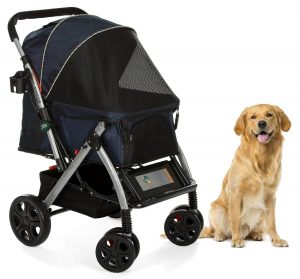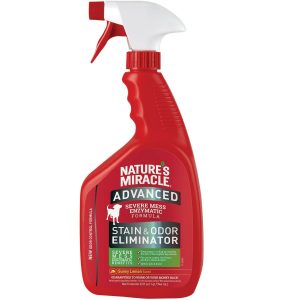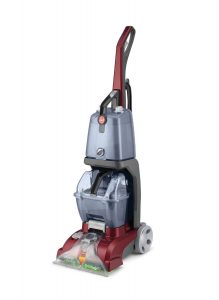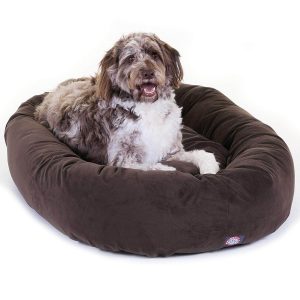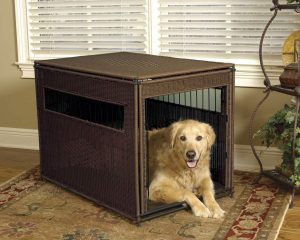
Many people see the crate as an inhumane tool and they do not want to confine their puppy to such a small area. Nevertheless, those same people limit their own baby’s area to a small cradle so they can prevent the baby from getting into trouble. If we can put a baby in a cradle, we can put a dog in a crate. As long as crate training is done in a proper way and for limited periods of time, it a very effective and humane training aid. The process in which we use to adapt the dog to the crate is gradual and happens over several days. In any case, your puppy should not be left in a crate for periods of time that extend his ability to hold his bladder and no more than 4-5 hours total at one stay.
It is important to note that a crate is not a magic solution to all dog behavior problems. While it is very effective in teaching housetraining and preventing destructiveness, it is contraindicated for behavior problems such as separation anxiety and other phobias. In fact, using a crate with those behavior problems can actually aggravate them.
Step by Step:
 The crate is a wonderful place full of surprises. This step teaches the puppy that many great things events in the crate:
The crate is a wonderful place full of surprises. This step teaches the puppy that many great things events in the crate:
- Put a comfortable blanket and a few toys inside the crate.
- Take some treats and show them to your dog. Feed the treats close to the crate and then throw some in. let your puppy walk inside the crate and eat the treats.
- Feed your puppy’s meals inside the crate.
- While your puppy is in the crate, throw treats in it in random intervals.
- Stuff a KONG™ toy with goodies and attracts your puppy’s attention to it. Place it in the crate and let your puppy enjoy it.
During this stage, we do not close the crate’s door. Continue this stage until your puppy looks happy and carefree around and in the crate.
Learning to enter and exit the crate on command.
Like step one, the crate’s door remains open. Teaching entering and exiting on command:
- When the puppy’s attention is on you and you are near the crate say “crate up” and throw a treat in the crate. The puppy will go inside and eat the treat.
- Now, say “come out” and let your puppy come to you. When he does, praise him but do not give a treat.
- Repeat the steps several times.
- Now, say “crate up” and do not throw the treat inside. Wait patiently for your puppy to enter and when he does, treat generously. If your puppy does not go inside, do not be tempted to throw the treat inside. Wait patiently and eventually he will. If he still doesn’t, end the training session and try again later from the beginning.
- Now, say “come out” and let your puppy come to you. When he does, praise him but do not give a treat.
- Repeat steps 4 and 5 several times. Make sure you don’t overdo it. End the training session after a couple of successes.
 Closing the crate’s door – the crate is fun even with the door closed.
Closing the crate’s door – the crate is fun even with the door closed.
- Set yourself up for a quiet evening in the house.
- Prepare several tasty puppy bones and a KONG™ toy stuffed with goodies.
- Tell your puppy to “crate up” when he walks in, give him the stuffed KONG™ or the tasty bone and close the crate’s door.
- Sit down next to the crate and watch TV or read a book. Walk away from time to time to the bathroom or to the kitchen, but always return within a minute.
- If the puppy starts whining or barking, ignore him. If you attend your puppy while he is whining, you will teach him to whine to get attention and this is the last thing you want him to learn.
- When your puppy is quiet, throw an extra treat into the crate at random intervals.
- When you are done watching TV and when the puppy is quiet, open the crate’s door. Don’t praise your dog or treat him for coming out. Continue your evening routine normally.
Extending the duration of stay in the crate:
- Set the crate at a location in the house where you spend most of your time at. The family room or the kitchen are usually good locations.
- Tell your puppy to crate up and close the door behind him. Make sure he has an interesting toy or bone to occupy himself with.
- Do your chores around the house while dropping a treat or two into the crate every once in a while.
- Do not pay attention to your puppy if he is whining or barking.
- Over a period of several days, try to gradually extend the durations the puppy is in the crate to about 3 hours.
 Staying in the crate when we are not at home.
Staying in the crate when we are not at home.
- This step is similar to step four but we must start at much shorter durations.
- Start with short trips outside. Getting the mail, visiting a neighbor, etc.
- Increase the durations gradually and make sure that your puppy is relatively quiet during the stay in the crate.
i. Ask a neighbor to note any whining or barking while you are away.
ii. Set a video camera and record your puppy’s behavior in your absence.
iii. You will be able to tell if your puppy is doing well in the training process or whether you need to decrease the durations of stay alone. - Make sure the puppy has a tasty bone or a cool toy with treats in it to occupy him.
- Do not leave the puppy in the crate for durations that are longer than his ability to hold his bladder and never more than 4-5 hours maximum.
In summary:
- Crate training is a great aid in the management and prevention of behavior problems such as destructive chewing and house soiling.
- If the dog adapts to the crate gradually, it becomes a safe and comfortable place for him to be in. it can later be used by the dog whenever he feels uncomfortable for some reason.
- The crate can be used as a good tool when taking your dog on the road and staying overnight at a strange place (camping, motels, etc)
- The crate is not meant to be used over 4-5 hours a day.
- The crate is not a solution for separation anxiety problems and can actually aggravate those problems.
- The method described here is one among many. as long as you are patient and desensitize your dog gradually to the crate, any other methods is fine.
- Consult a dog behaviorist if you encounter problems in your training.

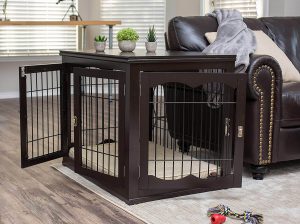 The crate is a wonderful place full of surprises. This step teaches the puppy that many great things events in the crate:
The crate is a wonderful place full of surprises. This step teaches the puppy that many great things events in the crate: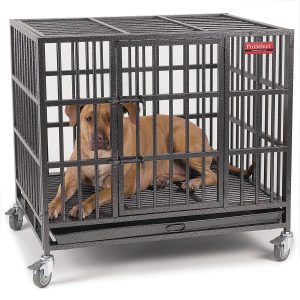 Closing the crate’s door – the crate is fun even with the door closed.
Closing the crate’s door – the crate is fun even with the door closed.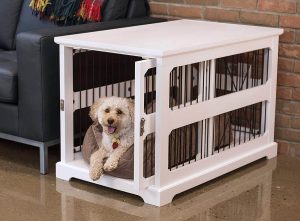 Staying in the crate when we are not at home.
Staying in the crate when we are not at home.

